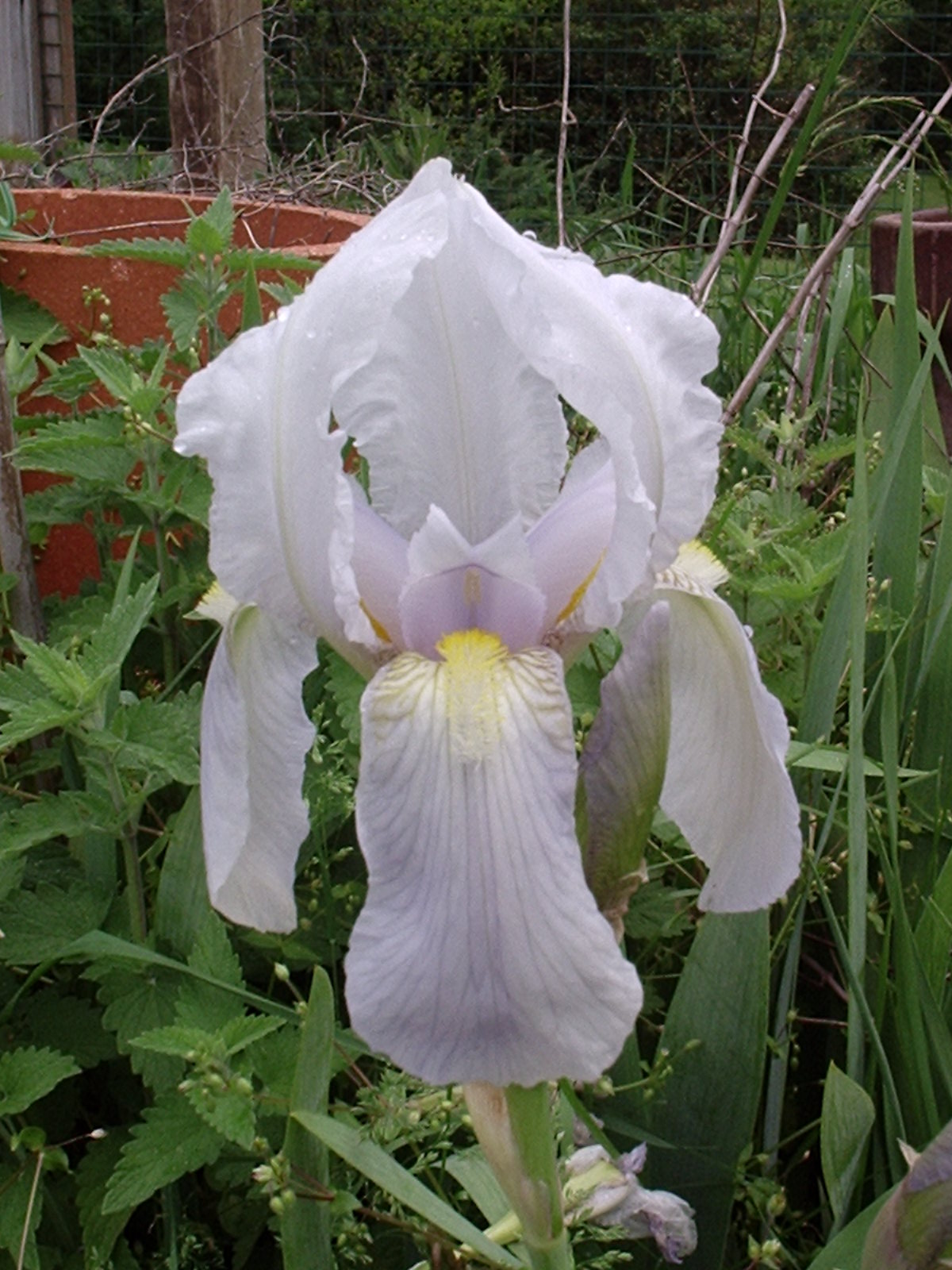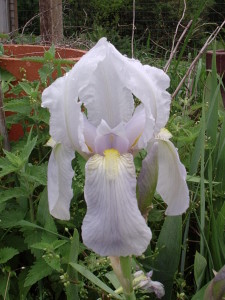Orris root, the sweet smelling component of many perfumes, has been used since the time of the Egyptian pharaohs. Technically it is the rhizome of the iris but if you try sniffing your iris rhizomes next time you are dividing them, you won’t smell anything. That’s because they need to be dried for at least two years and, in some cases up to five years, to develop their characteristic violet scent.
In the past, orris root has been used medicinally, in snuff and chewed to cover bad breath. In modern times, we use it as a fixative in potpourri and in many perfumes. Orris root is used to flavor gins such as Bombay Sapphire and Magellan. The flowers are used for color and flavor in those gins.
The rhizomes from three iris varieties are commonly used to produce orris root powder and essential oils. Iris germanica (bearded iris), which contrary to its name is not from Germany, in its original form sports a dark purple flower. Iris enthusiasts have bred bearded iris to produce flowers in in every color except true red. Iris pallida, which is native to the Dalmatian coast in Croatia and was probably the iris used to produce orris root powder by the ancient Greeks, has a lavender flower. Iris florentina, a variety of Iris germanica, is found in the area of Florence, Italy which was and continues to be a center of orris root production, is characterized by a pale purple almost white flower. It is the iris most often used for orris root.
Bearded iris including Iris florentina can grow to a height of 4 feet. Iris pallida, a smaller variety, grows to a maximum of 30 inches.
Bearded iris are easy to grow in your garden. They are hardy to zone 5. Iris require full sun and well-drained soil. The rhizomes should be planted so that the top half of the root is above the soil. If they are buried completely in the soil, they will rot. The roots which grow out of the sides of the rhizomes anchor them into the soil and prevent the plants from falling over. The rhizomes should be planted in the summer or early fall. The latest that you should plant them is 6 weeks before your first frost to give the roots a chance to become established before the plant goes dormant for the winter.
Bearded iris prefers to be dry so you should be careful to not over-water them. They do not require a lot of fertilizer. You can scratch in a little compost around the rhizomes. Alternatively, you can use a 6-10-10 fertilizer in the spring before your iris bloom and then again about a month after they finish blooming.
Iris are very hardy plants, not subject to as much disease as some the more delicate garden plants. Spacing helps keep them healthy also. Plant your rhizomes one to two feet apart to avoid crowding which can encourage disease to take hold among your plants. Their biggest enemy is the iris borer. Please click on the link to go to an article I wrote on another site about controlling iris borer in your garden.
Like any perennial, iris should be divided every 3 to 4 years. Division should be done after the plants finish blooming to give the roots the maximum amount of time to become established before winter. However, if you are growing iris for orris root, the rhizomes should be dug up in the fall. Iris reach maturity in three years, so you want to wait at least that long before harvesting them. Once you have dug the rhizomes up in the fall, you should store them in a single layer in a dry, well-ventilated space that does not get any sunlight. Rhizomes should be dried for at least two years. They are ready to be used when they are thoroughly dry and smell of violets. You can grind them up for orris root powder or distill them for their essential oil.



27 Comments on “Orris Root”
Have you ever chopped the freshly dug orris root into finer pieces before the 2 year cure?
No. The rhizomes should be dried whole.
How lovely. Wonderful post. I have this iris as I used to make potpourri, and it still remains. Perhaps I should again.
Where can I purchase the rhizomes?
You can try Old House Gardens: https://oldhousegardens.com/
Do you need a fixative in a potpourri but just add fragrance every week
Thank you cathy
Cathy, most people use a fixative so that they won’t have to add fragrance frequently. A fixative extends the life of the fragrance.
what is part used? is it only root, or root and rhizome?
The part of the plant that is used is the rhizome. The roots are cut off and discarded.
okay, thanks a lot!!
When dividing the Iris, there is often a central rhizome, is this the part we would use for orris?
You can use the entire rhizome and you will need to because you will be grinding them up after they are dried for powder. A single rhizome only makes a small amount of powder.
i understand that but for propagation usage, instead of throwing out the spent rhizome which wont flower can we use that as well?
Yes, you can use older rhizomes but they won’t produce as much fragrance as younger rhizomes.
Hello Herb Lady how are you.
can you use any variety of bearded iris ?
also we are in winter and have an open fire could I hurry the drying prosses by leaving them in this room,also I have dyhdrator could I use that.
Once they are dry could you hydrosol them at home on your stove.
thankyou cant wait for your responce
Unfortunately, not all varieties of bearded iris have fragrant rhizomes. For best results, use either the pallida or florentina species. I would not recommend either an open fire or a dehydrator to dry them because the rhizomes are very thick and take years to dry out completely. If you try to hurry the process, the rhizome may only dry out on the outside but not the inside.
Hydrosols are made with fresh leaves or flowers. As I pointed out in my article, when the rhizomes are fresh they have no fragrance. The fragrance develops when they are dried. Hydrosols made with fresh rhizomes would have no fragrance.
I have some very old(20 years approx) orris root. Would that still be alright to use in pot pouri?
I very much doubt that a root of that age would have still be able to be used in pot pourri. Like all herbs, orris root loses its potency over time.
Good evening,
How long does powdered orris root last please?
It depends on how it is stored. Most herbs will last for up to one year when stored properly. You can find information on how to store herbs here: https://advicefromtheherblady.com/growing-herbs/preserving-storing-your-herbs/
I am moving house this autumn. can I partially dry my orris roots, and then replant them in the new location?
No, unfortunately orris roots like all iris need to be kept moist. I suggest that you transplant your roots into a container, bring them to your new home in the container and transplant them into your new garden.
With other bearded iris, I have been able to salvage a percentage of dug, dried out rhizomes (1-3 months of being lost in the mess of my potting shed) such that they revive and go on blooming. Soak 5-24 hours in a dilute solution of high phosphorus water soluble fertilizer until they looks less wrinkled and leathery – won’t go back to looking fresh dug, but will be better than what you had. Then plant and treat them like regular iris, with a bit more water than usual. Works at least half the time for me. Don’t know if orris root iris will behave the same way.
The flower smells just like grape soda
Can Orris route be used for rooting powder?
Can Orris root be used for rooting powder to propagate other flowers please? I would like to use it for roses and lilacs.
Unfortunately, orris root is not a rooting powder.